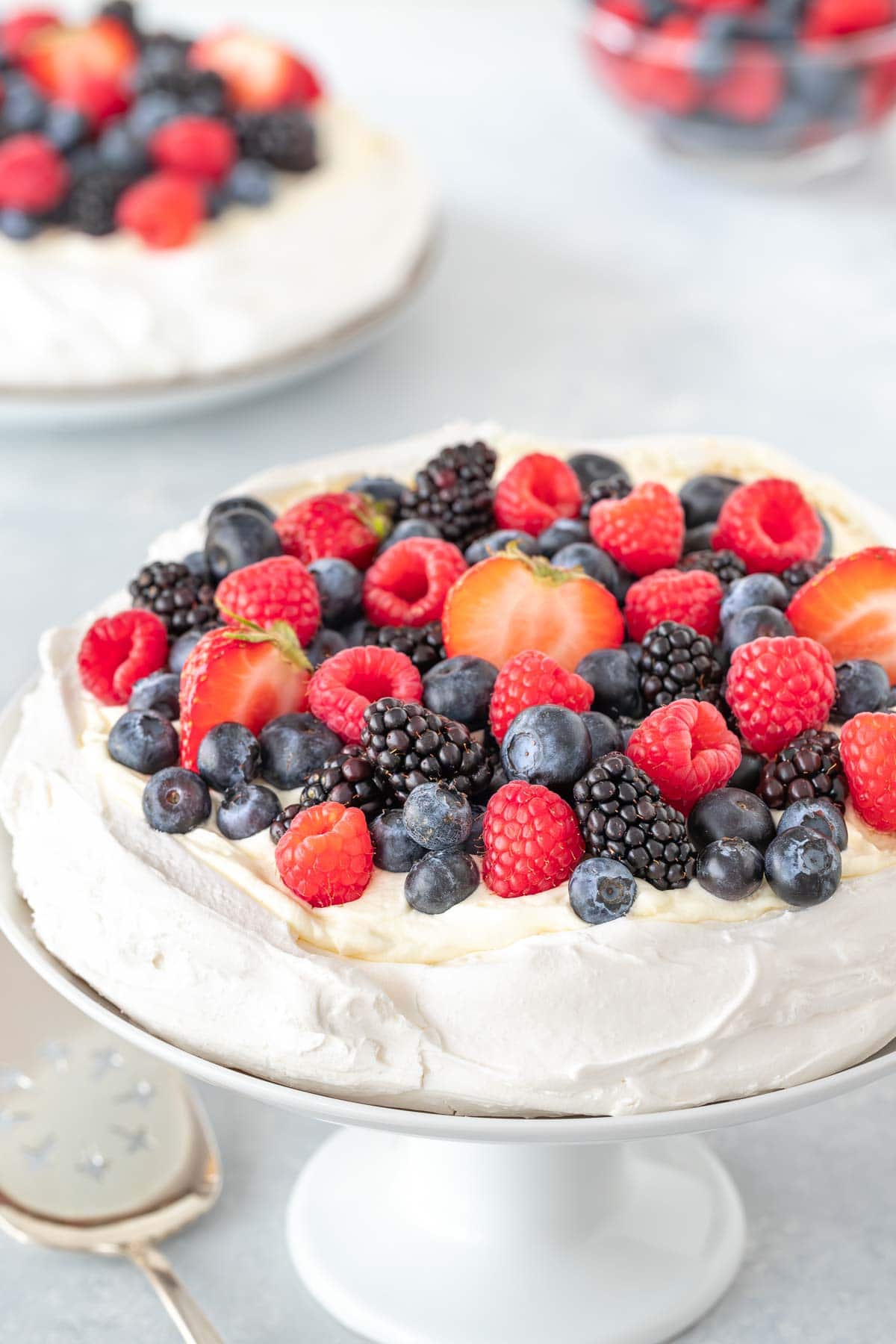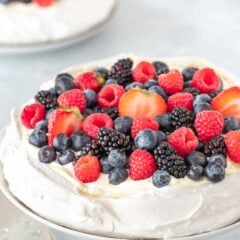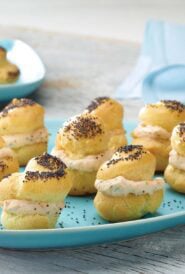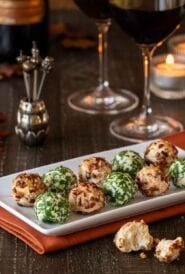Savor a delightful dessert and impress your guests with the Best Pavlova Recipe! This heavenly dessert is a delightful combination of crispy outside, chewy inside meringue, fluffy whipped cream, and bright, fresh fruit – a showstopper on any occasion. In this step-by-step guide, I’ll walk you through the process of making a Pavlova from scratch – from whipping the egg whites and sugar correctly for the base, all the way through assembling the final masterpiece. Plus, I’ll share all my tips and tricks for ensuring your Pavlova turns out flawlessly every time.
The Best Pavlova Recipe!
My mom, Sally, was first introduced to Pavlova by friends in Australia, whose family had been making it for generations – and they generously shared their recipe. As soon as she tasted it, mom knew she had found something extraordinary. Over the years, mom (and later I) tweaked the instructions to be more detailed and better suit our needs. We think this recipe for Pavlova works nearly perfectly for several reasons:
- Clear and detailed instructions. The recipe provides step-by-step guidance with lots of detail, minimizing any potential for error.
- Desirable texture. Pavlova’s appeal lies in its contrast of textures – a crisp outer shell and a soft, chewy interior. The combination of ingredients and technique used in this recipe ensure you achieve the that wonderful texture.
- Skillful egg white whipping. Whipping egg whites and sugar together is a critical step in making Pavlova, and requires a certain mix of ingredients and method to achieve the dessert’s needed structure and stability.
- Careful attention to cooling. Achieving that perfect texture requires no only precise baking, but also a defined cooling procedure – both of which allow the Pavlova to set properly without falling or weeping.
- Aesthetically pleasing. Pavlova is known for its stunning presentation, and in this recipe I include recommendations on toppings – and tips on how to arrange them.

What is Pavlova?
Pavlova, named after the famous Russian ballerina Anna Pavlova, is a meringue-based dessert that originated in either Australia or New Zealand (the debate is ongoing!). It was created to honor Pavlova’s visit to the region in the 1920s. The dessert is known for its light and airy texture, which is achieved by whipping egg whites and sugar to perfection.
Traditionally, you top the meringue base with whipped cream, fresh fruit, and sometimes a drizzle of sauce. Pavlova has become a beloved dessert in many countries around the world, with variations and creative twists being introduced over the years.
Pavlova vs Meringue
While both Pavlova and meringue are made from whipped egg whites and sugar, Pavlova has additional ingredients that give it a distinct texture and flavor. So, I guess you could say the base of a Pavlova is a type of meringue since it’s primary ingredients are the same.
Pavlova with Berries Ingredients
Here’s what you’ll need to make this masterpiece of a dessert:
Meringue Base (no substitutions here – these ingredients work together to give the Pavlova its signature texture and flavor)
- Granulated sugar
- Cornstarch
- Egg whites
- Table salt
- Cream of tartar
- White wine vinegar
- Vanilla extract
Whipped Cream Topping
- Heavy whipping cream
- Powdered (Confectioners’) sugar
- Vanilla-flavored brandy, Cointreau, or Grand Marnier, optional
- Vanilla extract
For Berry Topping
- Mixture of blueberries, blackberries, raspberries, sliced strawberries and/or peeled, sliced kiwi

How to Make Pavlova
Here’s a step-by-step guide for how to prepare the Pavlova meringue base. Note that this recipe makes 2 (7 inch) Pavlovas. You can use the same recipe to make 1 (9 inch) Pavlova.
- Prep oven and baking pan.
Preheat the oven to 250 degrees. In the middle of a piece of parchment paper cut to fit a half-sheet pan, draw two 7-inch circles that are at least 2 inches apart. Place on a half-sheet pan, circle side down. - Beat egg whites and sugar.
With an electric mixer fitted with the whisk attachment, beat the egg whites, salt, and cream of tartar together on medium speed (4 to 6), until frothy and starting to form soft peaks. Turn the mixer speed down to medium-low (3) and slowly add the remaining sugar to the egg white mixture, 1 tablespoon at a time. - Add cornstarch, vinegar and vanilla.
Next, add the sugar-cornstarch mixture, then the vinegar and vanilla. Beat on medium speed (4 to 6) until the mixture is glossy, forms stiff peaks, and the sugar is dissolved – 10 to 15 minutes. (To test if it’s ready, gently rub a small amount between your fingers. If it feels smooth with no granules, it’s good to go.) - Shape meringues.
Divide the meringue mixture evenly between the circles on your parchment paper – just plop it in the middle. Using a spatula, first smooth the outsides. Then slowly start spreading it out from the middle to around 1/2 to 1 inch from the circle. Next, take a spoon and spread the mixture so it’s slightly higher around the edges than in the middle. It should be around 7 inches in diameter now. Don’t worry about making it perfect – the beauty of Pavlova lies in its rustic charm! Bend down and look at the meringues from the side, to make sure they’re even. - Bake.
Place in oven and bake for 10 minutes. Reduce heat to 225 degrees and bake for an additional 70 minutes. When done, the meringues should be dry and crisp. They may crack around the edges, and that’s okay. Watch carefully starting at 60 minutes. You don’t want to see any weeping (small beads of liquid) – that means they’re getting overcooked. - Cool.
Turn off oven, leave the door closed, and leave meringues inside to cool for 1 1/2 hours. Prop the oven door open (I use a wooden spoon) and leave for another 30 minutes or until meringue is completely cool.

Tips for Making the Best Pavlova
- Avoid humid days. Humidity can interfere with the stability of the meringue, causing it to become soft and lose its structure. To achieve the desired crisp and chewy texture, it’s best to bake Pavlova in a dry and cool environment or on a day with low humidity.
- Use fresh eggs, and make sure there is no yolk in the separated whites – it can keep them from getting stiff.
- Use room temperature egg whites. To quickly bring egg whites to room temperature: place whites in a smaller bowl inside a larger bowl of warm water for 5 to 10 minutes.
- Make sure your mixing bowl and whisk attachment are clean and free from any grease or residue.
- Add sugar slowly, as called for in the recipe.
- Don’t overbeat the egg white-sugar mixture – this has to do with the speed you beat them on, not the amount of time! Beat no faster than medium speed. And, beat for 10 to 15 minutes – until glossy, stiff peaks form, and sugar is dissolved.
- Don’t stop beating the egg white-sugar mixture until the sugar is dissolved. To test if it’s ready, gently rub a small amount between your fingers. If it feels smooth with no granules, it’s good to go.
- Don’t open the oven door while the meringues are baking. Rapid exposure to cold can cause it to deflate.
- Cool baked meringue in the same oven, temperature off and door closed. Again, rapid exposure to cold can cause it to deflate. Some recipes call for propping the oven door open; I find a closed oven for the first 1 1/2 hours, then propping the door open works best.
- Don’t add toppings until just prior to serving – the bottom can start to break down and/or get soggy.
Pavlova Toppings and Variations
Our recipe for Pavlova calls for traditional toppings of whipped cream and fresh fruit. Specifically, we fill the meringue cavity with whipped cream spiked with liqueur, and top it with a medley of fresh berries. There are many, many other toppings you can use, including:
- Other flavors of whipped cream
- Other fruits – kiwi, peach, plum, mango
- Lemon curd
- Chocolate ganache
- Fruit jam
- Chopped toasted nuts
- Drizzle of chocolate sauce
- Garnish of mint leaves
- Sprinkle with powdered sugar (although it’s very sweet already)
In addition to the above, mom often served it with a raspberry sauce, which was delicious (recipe is in our first cookbook “A Well-Seasoned Kitchen®”).

Adding Flavors to the Meringue
While the classic Pavlova meringue base is wonderful as is, there are several possibilities for variations. Here are a few suggestions of ingredients that could be added to the egg white-sugar mixture:
- An extract such as almond, rum, or coconut
- Chopped toasted nuts
- Chocolate chips
Assembling Pavlova with Berries
Shortly before serving, fill meringue cavity with the whipped cream mixture (you may have some leftover). Spread the berries over the top. I start by scattering around a handful blueberries, then add blackberries and raspberries around and on top of the blueberries. Next, I add sliced strawberries and then finish with more blueberries.
How to Serve this Pavlova Recipe
Pavlova became my mom’s signature dessert and was served at many a dinner party and birthday celebration by request. I also have several Jewish friends who serve Pavlova for Passover Seder dinner, substituting whipped coconut milk for the whipped cream and omitting the alcohol.
Pavlova is best served fresh on the day it is made. The contrast between the crisp meringue and the soft whipped cream and fruit is what makes it so irresistible. Place Pavlovas on two large round serving dishes or cake stands. To slice, dip a sharp knife in hot water and slice slowly, from the midpoint of the Pavlova out.
How Far in Advance Can You Make Pavlova Base?
The meringue base can be prepared up to 2 days in advance, or frozen for up to 1 month (see storage details below).
How to Store Pavlova Dessert
If not using immediately, carefully remove meringues from parchment paper, wrap airtight with plastic wrap, and store at room temperature until ready to use (up to 2 days). Can also be frozen for up to 1 month. Thaw overnight in the refrigerator – note that the consistency may change a bit.
Unfortunately if your Pavlova is already decorated, it won’t last long – the toppings will make it soggy after 4 to 5 hours. So, eat up!
Print
Berry Pavlova Dessert Recipe
This heavenly dessert is a delightful combination of crispy outside, chewy inside meringue, fluffy whipped cream, and bright, fresh fruit – a showstopper on any occasion. In this step-by-step recipe, I’ll guide you through the process of making a Pavlova from scratch – from whipping the egg whites and sugar correctly for the base, all the way through assembling the final masterpiece.
- Yield: Makes 2 (7 inch) Pavlovas, serving 6 to 8 each 1x
- Diet: Gluten Free
Ingredients
Meringue Base
- 1 cup granulated sugar, divided
- 1 1/2 teaspoons cornstarch
- 1/2 cup (4 ounces) egg whites – from around 4 eggs
- 1/4 teaspoon table salt
- 1/2 teaspoon cream of tartar
- 1 1/2 teaspoons white wine vinegar
- 1 teaspoon vanilla extract
Whipped Cream Topping
- 2 cups heavy whipping cream
- 1/4 cup powdered (Confectioners’) sugar
- 1/4 cup vanilla-flavored brandy, Cointreau, or Grand Marnier, optional
- 1/4 teaspoon vanilla extract
For Berry Topping
- Mixture of blueberries, blackberries, raspberries, sliced strawberries and/or peeled, sliced kiwi
Instructions
Meringue Base
- Preheat the oven to 250 degrees. In the middle of a piece of parchment paper cut to fit a half-sheet pan, draw two 7-inch circles that are at least 2 inches apart. Place on a half-sheet pan, circle side down.
- In a small bowl, mix together 1 tablespoon of sugar and the cornstarch; set aside.
- With an electric mixer fitted with the whisk attachment, beat the egg whites, salt, and cream of tartar together on medium speed (4 to 6), until frothy.
- Turn the mixer speed down to medium-low (3) and slowly add the remaining sugar to the egg white mixture, 1 tablespoon at a time.
- Next, add the sugar-cornstarch mixture, then the vinegar and vanilla. Beat on medium speed (4 to 6) until the mixture is glossy, forms stiff peaks, and the sugar is dissolved – 10 to 15 minutes. (To test if it’s ready, gently rub a small amount between your fingers. If it feels smooth with no granules, it’s good to go.)
- Divide the meringue mixture evenly between the circles on your parchment paper – just plop it in the middle. Using a spatula, first smooth the outsides. Then slowly start spreading it out from the middle to around 1/2 to 1 inch from the circle. Next, take a spoon and spread the mixture so it’s slightly higher around the edges than in the middle. It should be around 7 inches in diameter now. Don’t worry about making it perfect – the beauty of Pavlova lies in its rustic charm!
- Bend down and look at the meringues from the side, to check and make sure they’re even.
- Place in oven and bake for 10 minutes.
- Reduce heat to 225 degrees and bake for an additional 70 minutes. When done, the meringues should be dry and crisp. It may crack around the edges, and that’s okay. Watch carefully starting at 60 minutes; if it starts to turn a light tan color, it’s probably done.
- Turn off oven, leave the door closed, and leave meringues inside to cool for 1 1/2 hours. Prop the oven door open (I use a wooden spoon) and leave for another 30 minutes or until meringue is completely cool.
- If not using immediately, carefully remove meringues from parchment paper, wrap airtight with plastic wrap, and store at room temperature until ready to use (up to 2 days). Can also be frozen for up to 1 month. Thaw overnight in the refrigerator – note that the consistency may change a bit.
Whipped Cream Topping
- With an electric mixer, beat the whipping cream, sugar, liquor, and vanilla until stiff peaks form.
Assembly
- Just before serving, spread the whipped cream mixture over the meringues, filling the inside (you may have some leftover). Spread the fruit over the top in a decorative pattern (see details in post).
- To slice, dip a sharp knife in hot water and slice slowly, from the inside point to the outside.
Notes
Variation for one (9-inch) meringue: Follow directions above except increase baking time to 90 minutes total (10 minutes at 250 degrees, plus 80 minutes at 225 degrees).
Make ahead: Meringues can be made up to 2 days in advance, wrapped airtight, and stored at room temperature. Can also be frozen for up to 1 month. The whipping cream can be made earlier in the day and stored in the refrigerator in an airtight container. Whip it slightly more than you would normally.
High altitude: No adjustments necessary (tested at 5200 and 8600 feet).
- Category: desserts, make ahead,
- Method: Bake
Nutrition
- Serving Size: 1 slice
- Calories: 124
- Sugar: 16.7 g
- Sodium: 53.5 mg
- Fat: 5.5 g
- Saturated Fat: 3.5 g
- Carbohydrates: 17.8 g
- Fiber: 0.4 g
- Protein: 1.4 g
- Cholesterol: 17 mg
Best Pavlova Recipe FAQs
Yes, Pavlova is gluten free.
Yes, you can make the meringue base up to 2 days in advance, wrap in plastic wrap and store at room temperature.
Pavlova is made from egg whites, sugar, cornstarch, vinegar, and sometimes vanilla extract. The addition of cornstarch and vinegar helps give Pavlova its unique texture—crispy on the outside and soft and chewy on the inside.






I made this for a dinner party and it was a HUGE hit. Everyone wanted seconds! Your tips were perfect – it didn’t deflate or crack!
Thanks Laura! I’m so happy to hear that our recipe worked well for you and that you and your guests enjoyed it.
Thanks for sharing at Let’s Get Real Friday Party.